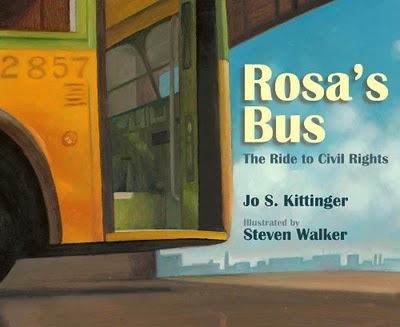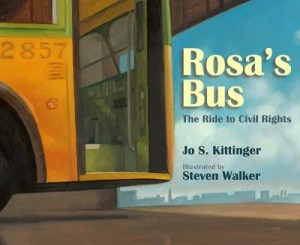14 Oct / Rosa’s Bus: The Ride to Civil Rights by Jo S. Kittinger, illustrated by Steven Walker

 Here’s a solid piece of history … literally! “When Bus #2857 rolled off the assembly line in 1948, no one cheered, no one paid attention, no one knew that one day Bus #2857 would be famous.” Author Jo S. Kittinger devises an ingenious way to tell a little known part of the Civil Rights story …
Here’s a solid piece of history … literally! “When Bus #2857 rolled off the assembly line in 1948, no one cheered, no one paid attention, no one knew that one day Bus #2857 would be famous.” Author Jo S. Kittinger devises an ingenious way to tell a little known part of the Civil Rights story …
Made in a General Motors plant in Michigan, Bus #2857 first worked in Indiana before settling in Montgomery, Alabama at six years old. It ran its routes with “a newly painted, movable sign. It read: Colored,” marking the rows 10 seats back.
Even though everyone paid the same dime, only the white passengers could sit up front. The “colored,” as African Americans were called back then, had to pay their dime, get back down, and use the rear door, and sit only in the back rows. “That’s just the way things were …”
On December 1, 1955, brave Rosa Parks got on Bus #2857 and refused to move to the back. With her single act, she changed American history.
For 382 days, Bus #2857 ran empty of African American passengers who protested the unjust laws with their city-wide bus boycott … until the Supreme Court finally listened. The Civil Rights Movement was gaining momentum …
When Bus #2857 was put out of service, it was saved from the junkyard, but languished in an open field, breaking down bit by bit, rusting year after year. Donnie Williams waited 30 years to save the bus, which would eventually return to Michigan to the Henry Ford Museum.
“Today Bus #2857 welcomes people of all colors …” It asks that we “imagine where it has been and where we have yet to go.” Indeed, the journey towards true equity continues to evolve and progress, notwithstanding the many bumps and twists along the way.
Readers: Children
Published: 2010

What a nice surprise to find my book shared in your blog today! Thank you, Terry, for opening its pages to your followers.
For all the teachers out there, you can find resources on my website to help incorportate ROSA’S BUS in your classroom studies.
Enjoy!
Wow, and how wonderful to find you in my comments page! Always thrilled with authors actually find BookDragon! And even more so when they write in!
Hope the book is doing well … deserves to for sure!
Thanks again and please come visit BookDragon again soon!